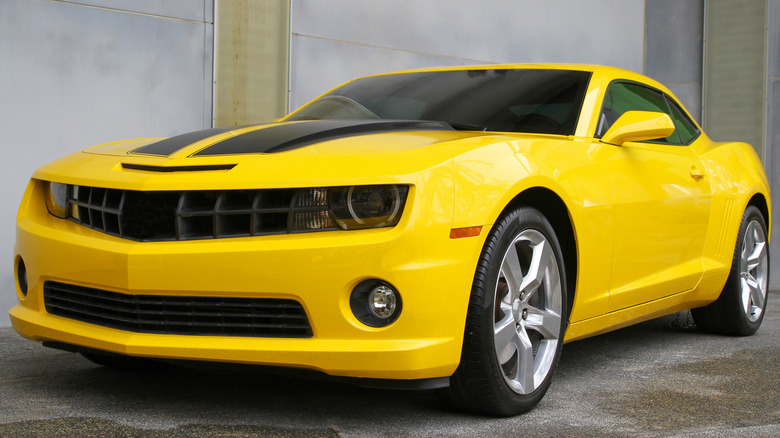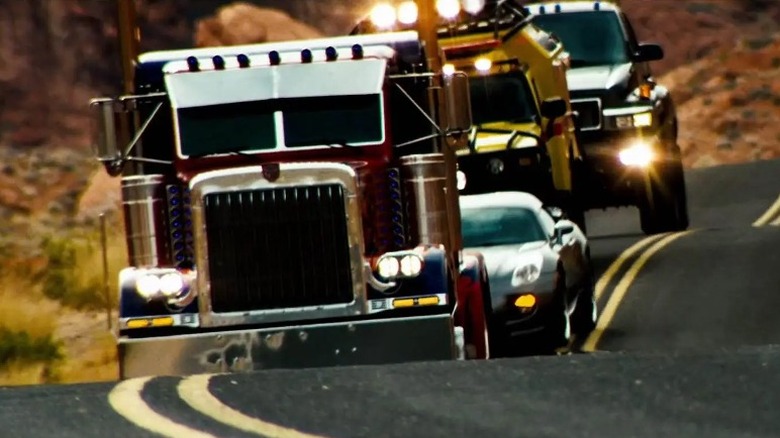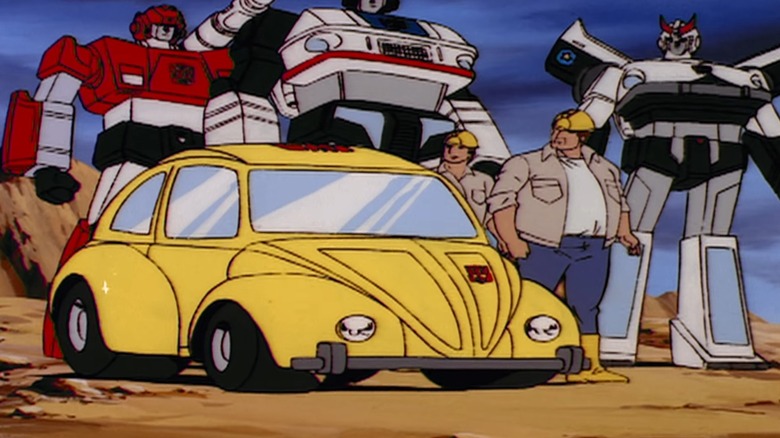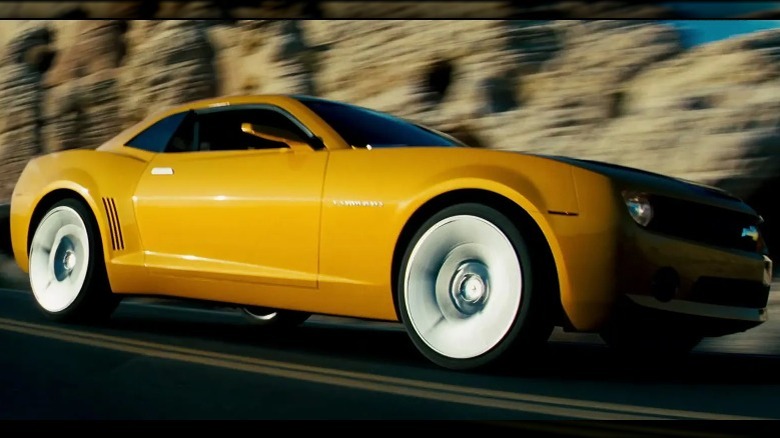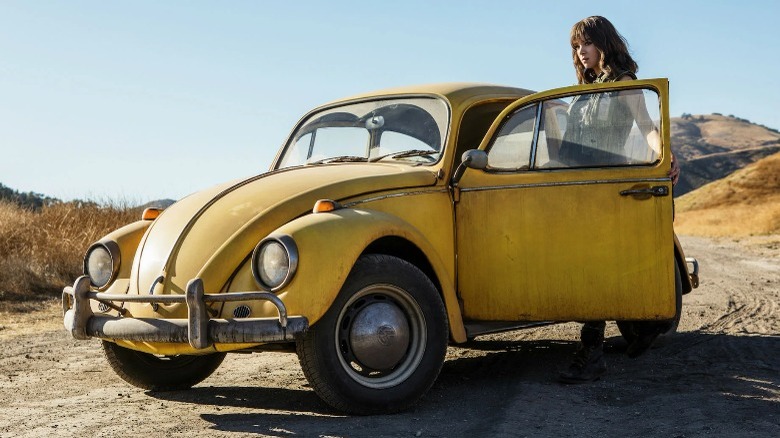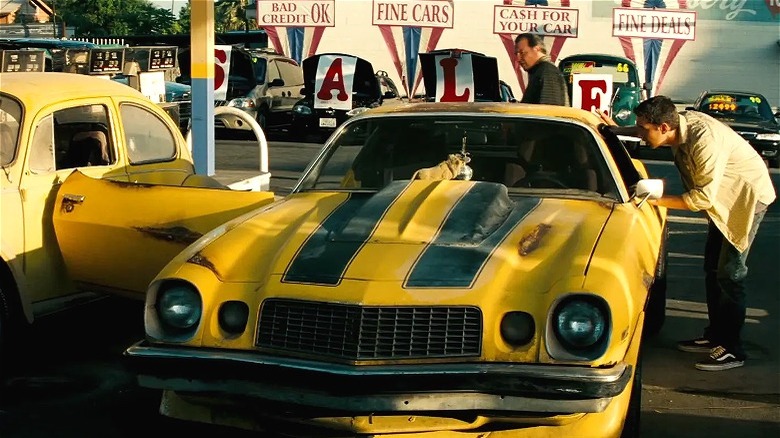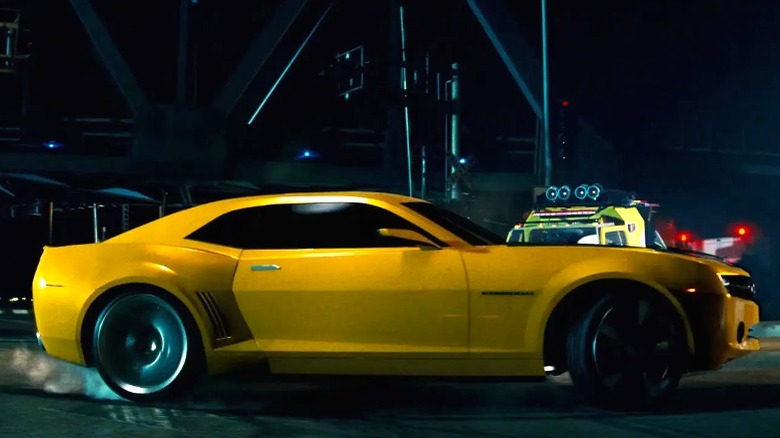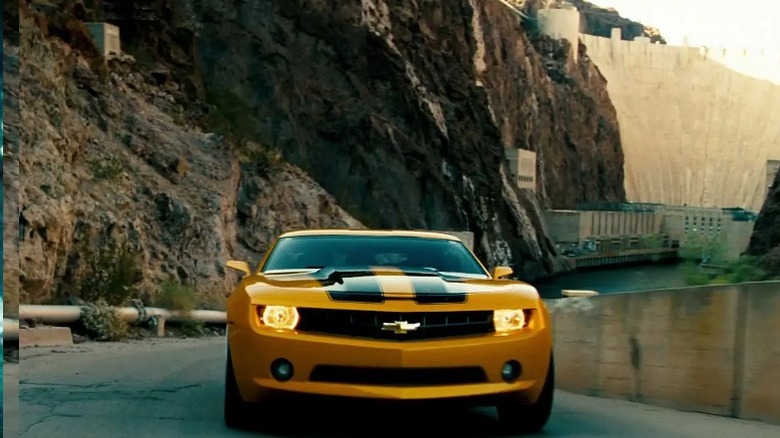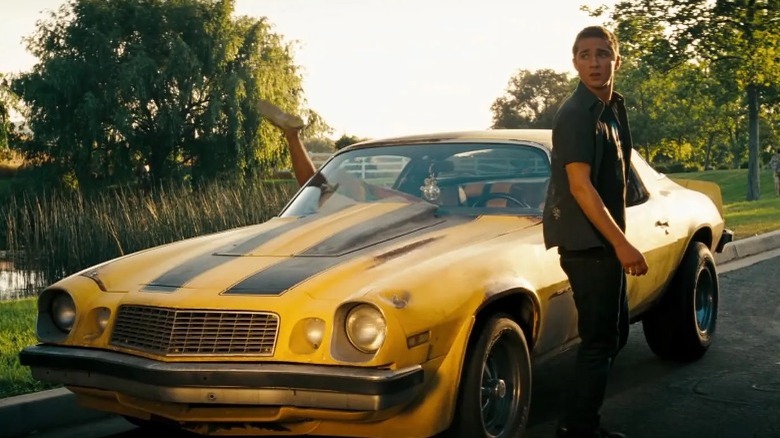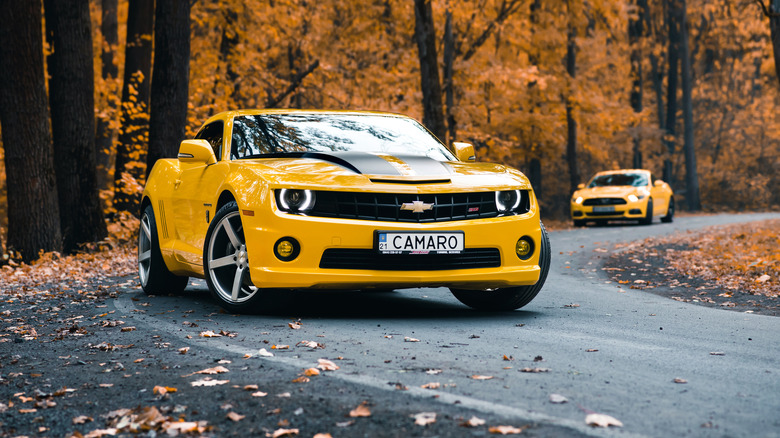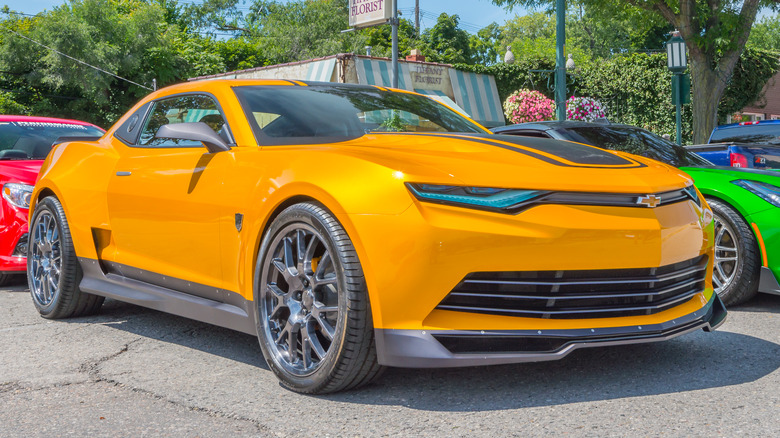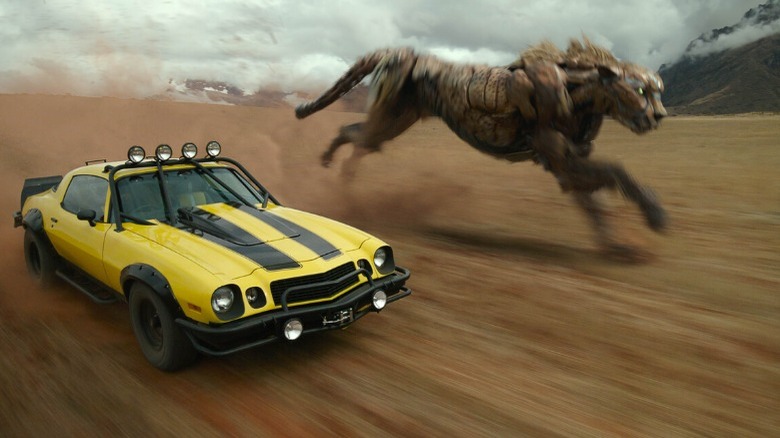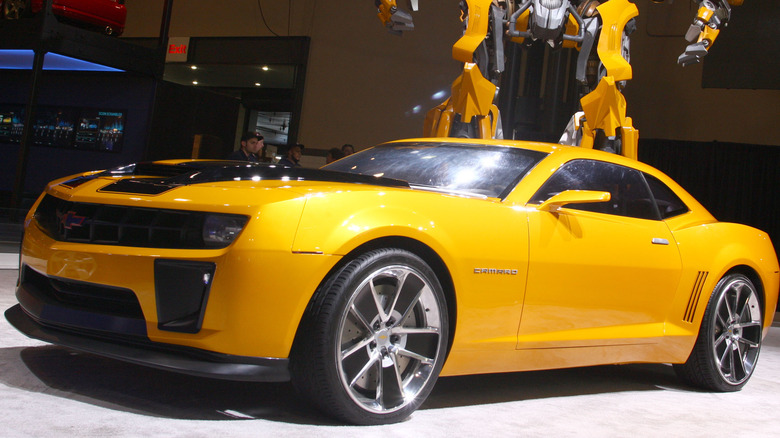Roll Out: The Story Behind The Bumblebee Camaro From Transformers
Although long-time fans showed some reticence when it was announced that Michael Bay was working on a live-action adaptation of the "Transformers" franchise, there is little doubt that his series has been anything other than successful. At the end of the day, the movies have grossed billions of dollars and brought the Autobots and Decepticons to legions of new fans.
However, taking the franchise from an animated cartoon to a live-action blockbuster film meant some changes had to be made, including the various robots' designs as they transformed into a variety of cars and motor vehicles. Nowhere is this more evident than with Bumblebee, the lovable yellow and black Autobot that now takes on the form of a Chevrolet Camaro, a sporty muscle car that is very different from his original incarnation.
Here is the story behind why Bay chose a Camaro for Bumblebee and how the design evolved throughout the history of the franchise.
The history of cars and Transformers
As the name suggests, the various characters in the "Transformers" franchise are known for their ability to transform into different forms. The Autobots and Decepticons often use vehicles from Earth to blend in and avoid detection while on the planet, with the various robot factions utilizing everything from standard cars to military transports as they journey around the world and continue their civil war. Using cars and other vehicles makes sense as it gives the Autobots and Decepticons a way to move around at high speed without revealing their true identities and drawing attention to themselves.
Throughout the history of "Transformers," the Autobots and Decepticons have often changed their appearance. However, most of the main characters are traditionally associated with a certain type of vehicle. For example, Optimus Prime is best known for his alternate form as a large truck, often a Freightliner or a Peterbilt, while the likes of Cliffjumper and Ratchet generally transform into a race car or an ambulance, respectively.
Meanwhile, the Decepticons are often more varied, with Megatron changing his form into pistols or tanks, while the rest of his villainous team includes robots that switch to fighter jets, police cars, and other military vehicles.
History of Bumblebee in the franchise
Bumblebee is one of the most popular and widely known of the many Autobots and Decepticons in the "Transformers" franchise. While Optimus Prime is the leader of the Autobots and Megatron is the main villain, Bumblebee has become a firm fan favorite and is possibly the most easily recognizable Transformer in the entire series.
From his introduction in the original cartoon, Bumblebee was always more of a relatable character than many of the other robots. He had a sense of humor and often interacted with humans in the show, providing a link with the audience. The character was also something of an underdog, the plucky hero who wasn't quite as big or strong as the other Transformers but could still be as effective due to his courage.
That has led to Bumblebee often appearing as a central protagonist in various cartoons, television series, and live-action films, making his distinctive yellow coloring a common sight in any "Transformers" property. In the original cartoon and the toy line associated with it, Bumblebee was portrayed as transforming into a Volkswagen Beetle – a holdover from the character's origins before Hasbro acquired the property from Takara Toys. For most of his history, the character was known for this form, but this changed with the release of the live-action films when his design was updated to appear more like a muscle car, and a new car was chosen instead.
Michael Bay wanted realistic and cool cars for his movies
When Michael Bay began work on the live-action movie adaptation of the series, he had a particular vision that meant many of the Autobots and Decepticons would have new alternate forms. As a director who mainly focuses on high-octane action films, the cute and colorful designs of old were no good — Bay wanted the Transformers to look cool rather than cute.
To accomplish this, Bay wanted realistic vehicles that looked authentic and matched up with the visuals of giant fighting robots. That makes a lot of sense for a director who is so associated with sexy and powerful cars in his movies. When it came to "Transformers" in 2007, Bay took a hands-on approach to picking the cars and wanted to avoid the aesthetics of the original cartoons as much as possible. While these earlier designs were memorable, they simply didn't fit with a fast-moving and intense action film that isn't trying to be charming or replicate a children's animated series.
The classic Volkswagen Beetle was quickly vetoed
One of the earliest decisions that Michael Bay made when it came to choosing the new cars for the Autobots and Decepticons came with Bumblebee. Out of all the vehicles in the earlier television and movie adaptations, Bumblebee was easily the most adorable, with the yellow Volkswagen Beetle giving the robot a cute and cuddly appearance, cementing him as the likable character that most appealed to younger viewers.
Obviously, that didn't fit with the ethos of the movie that Bay was trying to make. He quickly vetoed the idea of using the Volkswagen Beetle and set about looking for an alternative. "I just was never going to use the Volkswagen Bug for Bumblebee," Bay explained in a behind-the-scenes feature. "It just reminded me of Herbie the Love Bug."
That doesn't mean the classic vehicle is entirely missing from the "Transformers" movie. At the start of the film, when Sam (Shia LaBeouf) goes with his father (Kevin Dunn) to buy his first car, Bumblebee is located alongside a beat-up Volkswagen Beetle that a salesman tries to get him to take home instead.
Sponsorship played a huge role in picking the cars
Many people may not realize that it wasn't just Michael Bay or the other filmmakers involved who helped pick the cars that the Transformers would use as their alternate forms. Money also played a crucial role, specifically sponsorships from car manufacturers to have their models prominently featured in the movie. This concept is nothing new. After all, movies can be very expensive to make, and product placement deals are a useful way to offset some of the costs.
With the 2007 film having an estimated budget of $150 million, being able to recoup some of that money was essential during the production process. Randy Peters, who served as the transportation coordinator, explained that car manufacturers seemed like the perfect choice considering how much screen time the vehicles would have.
Various companies submitted bids to Bay and the producers, competing to showcase their range of cars. In essence, manufacturers saw the movie, as well as potential future sequels and spin-offs, as a huge commercial to advertise products, which helped determine the product lines that the Transformers would change into.
General Motors eventually came out on top
Randy Peters explained in the behind-the-scenes footage that General Motors put in the best offer and that the producers were impressed with its attractive cars. It wasn't just money that made General Motors an attractive proposition — Michael Bay already had an established relationship with the company, featuring its cars in previous films and even directing some commercials for its various brands.
In addition, General Motors has also worked extensively in Hollywood before and knows what to expect."It's a company that understands Hollywood's work process, and you need that," said producer Lorenzo di Bonaventura to NBC News. "In many ways, we couldn't have made this movie without a company like GM."
Other manufacturers have featured in the franchise, most notably the likes of Ford, Mercedes, and Bugatti, but the vast majority of cars are General Motors models. This is especially true for the heroic Autobots who get the most screen time and are the protagonists of the film.
Michael Bay knew Bumblebee would be a Camaro as soon as he saw the car
As he mentions in the behind-the-scenes feature for "Transformers," Michael Bay knew he had found the right car from the moment he first saw the Camaro. "What I liked about it was it kind of had a retro look," he said. "It was a muscle car, and right then and there I knew it was Bumblebee."
Bay told Car and Driver that General Motors was particularly accommodating during visits when the director was looking at potential cars for the film. "I walked into a special secret facility they have where they develop prototypes, and they said, 'Let us show you what we've got,'" he revealed. "I saw the new Camaro, and I think they were on the fence about making it, and I said, 'That's the car.' So they made a prototype for us."
This relationship has continued, with Bay explaining how he gets early access to General Motors concepts. He said: "When I go to GM, Ed Welburn, their global design vice president, literally takes me through all their design rooms and says, 'What do you like?'"
Bumblebee first appeared as an older 1976 Camaro model
Despite the fact that Bumblebee's main alternate form throughout the first movie is a 2006 Camaro, that isn't how he is first depicted. When the character is initially shown on screen, the Autobot is rusting away at a car dealership. Shia LaBeouf's character Sam visits the location to purchase his first car and immediately falls in love with a 1976 Chevrolet Camaro. This makes sense, as there's no way a youngster like Sam would be able to afford a brand-new Camaro.
Sam's love interest and friend Mikaela (Megan Fox) later suggests that Bumblebee should have a more modern look that better fits with his persona. The robot scans a 2006 Camaro and switches it for the classic model, sticking with the updated appearance throughout the rest of the film. Finding classic versions of the car wasn't easy though, with the producers having to search far and wide to get several of the 1976 Camaros to use for stunts.
"Nobody wanted them, nobody needs them, they're hard to find," producer Brian Goldner explained in a behind-the-scenes feature. "This one was pulled out of Palmdale, the other two were pulled out of Oklahoma. We're gonna redo 'em, repaint 'em, new engines, everything redone so that [stuntman] Kenny Bates can drive the heck out of 'em for these stunts."
Chevrolet provided a newly designed Camaro for each movie
In the first movie that was released in 2007, Bumblebee took the form of two different Chevrolet Camaros. The first is the 2nd Generation 1977 Camaro, and the second is a 5th Generation 2006 Camaro Concept, a version of which would eventually hit the market as the 2010 Camaro SS.
Michael Bay stuck with the Camaro for the various sequels that have hit cinema screens in the intervening years, such as an older 1st Generation 1967 SS and a 6th Generation 2014 Concept. In fact, the Camaro has almost become arguably as synonymous with the character as the Volkswagen Beetle originally was, with Hasbro utilizing the design for the character across toys and television series.
The partnership between Bay and General Motors meant that Chevrolet was willing to provide a brand-new version of the Camaro for each subsequent film. This includes special concept versions of General Motors cars that are not due to hit production for several years, which helps make them truly unique as they are not available for any other movie.
Age of Extinction saw Bumblebee take on the form of a unique concept Camaro
For "Transformers: Age of Extinction," director Michael Bay wanted to have a more distinctive cinematic look. Speaking to Yahoo, Bay explained that he felt the earlier films were a little too goofy and that the fourth film needed to have a fresh visual style. "I wanted the first 'Transformers' to be very suburban and less cool," Bay said in the interview. "This is a much more cinematic one. I focused on keeping this one slick. There won't be any goofiness in this one."
Of course, that meant that the various Autobots and Decepticons would also have an updated appearance. For the 2014 film, General Motors once again provided Bay with a unique concept car. This model was never intended to go into production and was instead designed to showcase what a next-generation Camaro might look like in the future. At the time, Motor Trend reported that Bay described the vehicle as the "final jewel in the 'Transformers 4' crown" after revealing it on the movie's official site.
Transformers: Rise of the Beasts sees the character go back to his Camaro roots
The latest entry in the live-action "Transformers" movie franchise is the 2023 movie "Transformers: Rise of the Beasts." While Michael Bay did not take on directing duties for the film, instead handing over the reins to Steven Caple Jr., he still acted as producer and played an important role in the film's production. In fact, it was even reported that Bay still holds a veto for the franchise and takes an active role in the production.
That might be why most of the characters in this film follow a very similar design to their predecessors and Bumblebee is once again a Camaro in the latest film. However, because "Transformers: Rise of the Beasts:" is a prequel that takes place before the original, the character doesn't use any of the more modern versions of the car. Instead, Bumblebee goes back to his roots and takes on the form of a 1977 Camaro, the original form he had when Sam first saw him.
However, this version of the Autobot also comes with some previously unseen upgrades that help make this version of the 1977 Camaro truly unique. These include elements such as off-road tires, roof-mounted headlights, a custom roll cage, and upgraded suspension.
The movies have boosted the sales of the Camaro
Although there have been no indications about how much General Motors paid to take on such a prominent role in the "Transformers" movies, it was likely a significant figure. However, that money has seemingly been well spent, with General Motors keen to keep up the partnership across the more than half a dozen films that have been released so far.
For General Motors, the movies provided the company with a way of getting its cars in front of a younger audience that it had previously not been able to reach. "In all the 'Transformers' films, Chevrolet vehicles get to play the heroes," explained Chevrolet chief marketing officer Tim Mahoney to Variety. "These movies have helped us get our vehicles in front of a younger audience around the world."
According to figures released by General Motors and Chevrolet, the movies have led to an increased interest in the Camaro in particular, with sales rising by thousands. Yellow versions of the car have seen a particularly strong spike following the release of each film in the series. The fact that the cars feature in toys, television shows, and rides also expands the reach even more and gets more eyes on the different General Motors cars showcased in the "Transformers" films.
